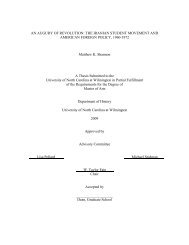Saprolegnia - The iLumina Digital Library
Saprolegnia - The iLumina Digital Library
Saprolegnia - The iLumina Digital Library
Create successful ePaper yourself
Turn your PDF publications into a flip-book with our unique Google optimized e-Paper software.
According to Dick (1969a), the delicate, flexuous mycelium and the “gritty”<br />
granular aspect of the hyphae were characteristic of the three species assigned to<br />
Scoliolegnia. He remarked that this mycelial texture contrasted with the stout, straight<br />
hyphae prominent in species of <strong>Saprolegnia</strong> and Isoachlya. <strong>The</strong>se characters alone,<br />
however, did not form the sole basis on which Scoliolegnia was established.<br />
Dick (1969a) concluded that the genera of <strong>Saprolegnia</strong>ceae were defined on too<br />
few characters. Accordingly, he compared and contrasted the species of Scoliolegnia on<br />
twenty structural criteria. <strong>The</strong> descriptive matter provided by Dick (particularly the<br />
characterization in Table 1 of his 1969a account), and the accompanying illustrations<br />
permit but one conclusion: there are essentially only two features that could possibly be<br />
used to distinguish Scoliolegnia species from members of <strong>Saprolegnia</strong>. <strong>The</strong>se are, for<br />
Scoliolegnia, the flexuous hyphae and the flared aspect of the rather prominent exit<br />
papilla after it has opened terminally at spore emergence. <strong>The</strong> first characteristic<br />
(mycelial texture) is, in fact, one by which de Bary’s <strong>Saprolegnia</strong> asterophora (one of the<br />
species assigned to Scoliolegnia) usually can be recognized in water culture; Dick’s two<br />
new species of Scoliolegnia also at times may be made out in gross culture on this<br />
feature. <strong>The</strong> prominently flared, opened exit papilla is not a consistent characteristic of<br />
<strong>Saprolegnia</strong> asterophora, and other species of <strong>Saprolegnia</strong> sometimes produce similar ones.<br />
Other structural features that Dick used to circumscribe his species, such as mean<br />
diameters of the exit papillae and of the oogonial stalks, are in our judgment too<br />
variable to be of value at the species level, to say nothing of the generic level. In any<br />
event, Dick did not mention the conspicuous nature of the exit papilla remnants in the<br />
formal description of Scoliolegnia.<br />
We find commendable Dick’s (1969a) argument that genera should be defined on<br />
the basis of several characters, but his contention falls short with respect to Scoliolegnia,<br />
since that genus rests in our view on only two criteria. In what we regard as a<br />
fundamental morphological characteristic essential for generic delimitation -- spore<br />
discharge pattern and sporangial renewal -- Scoliolegnia species cannot be distinguished<br />
from those of <strong>Saprolegnia</strong>. We interpret Dick’s argument favoring the recognition of<br />
Scoliolegnia basically to be a proposition that generic determinations in the<br />
<strong>Saprolegnia</strong>ceae may be made independent of reliance on sporangial renewal method.<br />
Admitting to <strong>Saprolegnia</strong> species with flexuous hyphae does not at all distort that<br />
genus into an unrecognizable complex. <strong>The</strong> same may be said for including species<br />
with subeccentric oospores. Indeed the concept of <strong>Saprolegnia</strong> is more firmly and<br />
competently established by the admission of Dick’s Scoliolegnia species.<br />
As with Achlya, <strong>Saprolegnia</strong> has been variously divided into infrageneric units.<br />
Schröter (1893) accepted three subgenera: Eusaprolegnia (the S. ferax group), Desmolegnia<br />
(the S. monoica complex), and Astrolegnia. Coker (1923) recognized Eusaprolegnia with<br />
four “Groups” -- Diclina, Ferax, Hypogyna, and Torulosa -- and Pseudosaprolegnia, with the<br />
single species, S. asterophora. In 1959(a), Cejp raised Coker’s Hypogyna and Diclina<br />
groups to section status (in the subgenus Eusaprolegnia, and did likewise with the Ferax<br />
group, which he attributed to de Bary. In addition, Cejp (1959a:251) proposed a fourth<br />
taxon in Eusaprolegnia, the Section Terrestres. Three subgenera of <strong>Saprolegnia</strong> --<br />
600
















